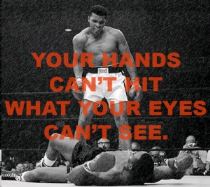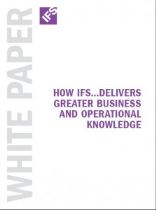In a previous post on the importance of operational knowledge to business agility, we use a colorful analogy make clear that if you can’t see what is happening in real time, you cannot adjust to change as it unfolds.
No Single Individual Stands Out Like The Greatest
 Perhaps the best agility lessons come from the world of sports, where competitors react to events as they unfold, making fluid, real time adjustments. And when it comes to the importance of real time operational knowledge, no single individual stands out in the mind like the greatest, Muhammad Ali. One of a number of things that made Ali unique was his ability to get out of the way of an attack, to make guys miss. Not only did Ali have incredible footwork, but he would lean back and to the left, forcing a competitor to over-extend themselves. It was at this moment, as the opponent’s arm was extended and the head was exposed, that Ali’s “anchor” punch would come shooting out in a mere four one hundredths of a second.
Perhaps the best agility lessons come from the world of sports, where competitors react to events as they unfold, making fluid, real time adjustments. And when it comes to the importance of real time operational knowledge, no single individual stands out in the mind like the greatest, Muhammad Ali. One of a number of things that made Ali unique was his ability to get out of the way of an attack, to make guys miss. Not only did Ali have incredible footwork, but he would lean back and to the left, forcing a competitor to over-extend themselves. It was at this moment, as the opponent’s arm was extended and the head was exposed, that Ali’s “anchor” punch would come shooting out in a mere four one hundredths of a second.
This counter-maneuver required keen awareness of the position and movement of the opponent, split-second timing and the body awareness that only elite athletes have. This is exactly what we need as managers and executives of complex industries. We need to respond more quickly to threats than our competitors can, and capitalize on openings more rapidly. As we have expounded on in earlier installments of the Business Agility Series, enterprise software has a central role to play in ensuring that we can react to change quickly — negating threats and taking advantage of opportunities.

Download the whitepaper on how IFS delivers enhanced operational knowledge important for business agility!
A Lesson in Business Agility
But in the context of a medium-sized to large enterprise, how do we maintain constant awareness of facts on the ground, within our walls, in the supply chain and among the customer base? Ali had only to think about his opponent, where he was in the ring (so he could stay out of corners if necessary), where he was on the scorecard and how many minutes and seconds were left in each round. A modern executive has exponentially more variables to take into consideration, many of them moving rapidly and often too distant to be monitored effectively without appropriate enterprise technology.
Your hands can’t hit what your eyes can’t see. So operational knowledge becomes a key factor in ensuring business agility.
So how do we gain the operational knowledge required to enjoy full-fledged business agility? In the latest whitepaper in the heralded Business Agility series, we look at exactly how we at IFS go about facilitating this operational vision for our customers. How do we give you that body awareness of an elite athlete and the ability to sense and respond to your environment. In “How IFS Software Delivers Greater Business and Operational Knowledge,” we share our solutions’ approach to:
- Assembling a single version of the truth: business lifecycle expertise. IFS software enables you to understand the status of your products, assets, customers and projects at any time, with a reliable single version of the truth.
- Extending knowledge and information: built-in mobility and usability. Put clear, usable information into the hands of the people who need it, in the boardroom, warehouse, and out in the field.
- Understanding future scenarios: forecasting and modelling tools. IFS software enables you to bridge the knowledge gap between strategy and operations, and accurately model and understand the impact and dependencies of future business scenarios.
To close on the boxing analogy, if you are flying blind, you are in danger. Enough blows to the eye, or an alleged irritating substance on an opponent’s glove and you can barely sense anything. You and your organization will be hard-pressed to meet your goals, or even survive to the next round. Enterprise software — be it enterprise resource planning (ERP) software, service management or enterprise asset management (EAM), is that central nervous system of your business, the one version of the truth that you can look to with confidence in real time. Get the whitepaper today to see how IFS helps you draw real time insights from the state of your projects, products, assets, customers, suppliers and services. And then act directly on those insights.
manojgupta3712
It’s amazing how so much can be done with such information. Was scrolling through your blog and it really caught my attention. I had to save it to read later.
Kudos for collating great insights at one place. Thanks! :)